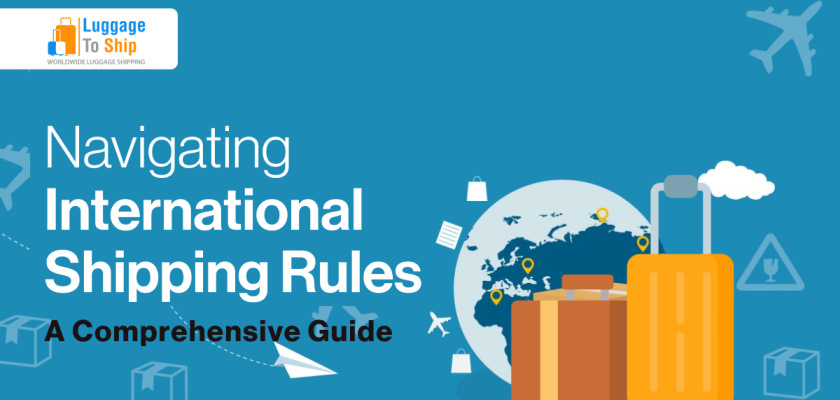Welcome to our comprehensive guide on navigating international shipping rules! Whether you’re a seasoned international traveler or a first-time shipper sending packages overseas, understanding the rules and regulations can make all the difference in a successful shipping experience.
With so many different countries and regulations to consider, it can be overwhelming to know where to start. That’s where we come in to break down the complexities and provide you with a clear and concise guide to help you navigate the world of international shipping.
Understanding the Basics of International Shipping Rules
Navigating the world of international shipping rules may seem complex, but it’s crucial for businesses looking to expand globally. Here’s a simplified guide to help you understand the basics:
Know the Rules: Each country has its own set of shipping laws and regulations. By understanding these rules, you can ensure the smooth passage of your goods across borders.
Get the Documents Right: Proper documentation is key to international shipping rules. Make sure you have all the necessary paperwork in order to avoid delays or complications.
Understand Shipping Agreements: Knowing the agreements that govern shipping rates and the categorization of goods can help you calculate costs accurately and stay compliant with regulations.
Learn About Shipping Zones: Different parts of the world fall into different shipping zones, each with its own rules and regulations. Understanding these zones can help you plan your logistics more efficiently.
Balance Legal Requirements: Balancing the legal requirements of both the country you’re shipping from and the country you’re shipping to can be challenging. However, it’s essential for successful international transactions.
Optimize for Efficiency: Ultimately, mastering the basics of international shipping rules allows you to optimize for both time and cost efficiency, setting the stage for successful global trade.
Key Documents Required for International Shipping
The following documents are indispensable for international shipping:
Commercial Invoice: It details the transaction between buyer and seller, including item descriptions, quantities, prices, and terms of sale.
Packing List: It provides a comprehensive list of the contents of the shipment, aiding customs officials in verifying the cargo.
Bill of Lading (BOL): It serves as a contract between the shipper and carrier, outlining the terms and conditions of transportation and confirming receipt of goods.
Certificate of Origin: It certifies the country where the goods were manufactured, which can impact duty rates and trade agreements.
Import/Export Licenses: Depending on the destination and type of goods, licenses may be required to comply with local regulations and trade restrictions.
Inspection Certifications: Some countries mandate inspections to ensure compliance with quality, safety, or health standards before allowing entry of goods.
Navigating Customs Regulations and Procedures

The process of clearing customs is a pivotal aspect of international shipping rules, necessitating meticulous preparation and understanding of local and international regulations
Thorough and accurate documentation is essential for successful customs clearance, which includes the correct classification of a shipment with the universally utilized Harmonized System (HS) codes.
To ensure a smooth transit of goods, it’s important to understand the customs requirements of both the originating and destination countries.
Making mistakes in classification, undervaluing declarations, or submitting incomplete paperwork can lead to delays, fines, or even the seizure of goods.
To navigate customs procedures with greater confidence and efficiency, it’s crucial to prioritize accuracy in documentation and stay informed about the regulatory landscape.
Packaging and Labeling Requirements
International shipping requires specific packaging and labeling standards. Each country has its own guidelines for acceptable packaging and labeling, including instructions for handling, material content, and origin. It’s essential to comply with these requirements, or you may face delays, or your items will not reach their destination in time.
Shipping Restricted and Prohibited Items
When shipping internationally, it’s crucial to follow the destination country’s list of restricted and prohibited items. Regulations on hazardous materials are strict. Consult the most up-to-date guidelines from the customs authority and work with a knowledgeable customs broker or freight forwarder to avoid legal complications and streamline the shipping process.
Insurance and Risk Management in International Shipping Rules
International shipping exposes businesses to risks from the moment goods leave the warehouse until they reach the buyer. Securing the right insurance coverage is crucial to protect against potential financial losses. Options range from basic liability to comprehensive all-risk policies. Understanding specific risks and incorporating risk management strategies can mitigate potential issues. Seek guidance from an insurance provider experienced in international logistics for tailored advice and peace of mind.
Embracing Technology for Efficient International Shipping Rules
Advanced technologies have transformed international shipping by streamlining operations and improving accuracy. Tracking systems offer real-time visibility of shipments, while automated customs clearance platforms and digital document management tools simplify complex processes and improve compliance.
By embracing technology, businesses can enjoy a more transparent, reliable, and simplified shipping process, allowing them to focus on growth and customer satisfaction.
Frequently Asked Questions about International Shipping Rules
How can I determine the correct HS code for my product?
Locate HS codes by accessing your nation’s customs website or engaging with a customs broker or freight forwarder for expert advice.
Are there any items I cannot ship internationally?
Yes, each country has its own list of restricted and prohibited items. Always verify the specific regulations of the destination country prior to shipping.
What factors influence the cost of shipping internationally?
International shipping rates are influenced by the shipment’s weight, dimensions, selected transportation method, and the distance between the origin and destination countries.
How do I ensure my shipment complies with the destination country’s customs regulations?
Familiarize yourself with the destination country’s customs regulations, accurately complete all required documents, and consider consulting a customs broker for guidance.
Final Words
Embarking on the journey of international shipping can seem like a daunting task at first glance. Yet, with a dedication to understanding the nuances of shipping regulations, maintaining accurate documentation, and staying informed about customs procedures, businesses can smoothly navigate these waters. The use of technology and seeking professional advice when needed further streamlines the process, allowing companies to focus on expanding their global reach. It’s essential to stay up-to-date with the evolving landscape of international trade laws to avoid pitfalls and optimize your shipping strategy. As you adapt and learn from each shipment, the complexities of international logistics will become more manageable, enabling your business to thrive in the global marketplace.


